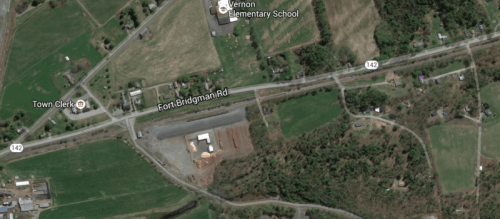Where’s downtown Vernon?
By Barbara Emery Moseley, as told to Kathy Korb
How did Vernon go from having three “centers” in the early days of the town to having none today? This is the story of how all three Vernon centers disappeared, leaving the town with no real location which feels like a focal point now.
In the 1800s, when the town was young, it was rich with three centers. Each one was fully functioning with a hotel, a railroad depot, and a post office. Two also had churches, businesses, and stores. The arrival of the railroad in 1849 brought easy access and mass transportation to Vernon. With this came a need for services to meet the needs of the passengers and townspeople, causing the other enterprises to follow.
The first depot was built in North Vernon when the railroad arrived in 1849. That same year the Burrows House was erected by Jarvis F. Burrows as a business venture to take advantage of the railroad depot across the road. This building has had multiple incarnations over the years and has always been an important town structure. Sometime before the end of that century a post office was opened in the little railroad station, helping make this area an important point of trade and communication, as by then, other business were also located there.
The second depot was built in South Vernon, right on the state line with Massachusetts. The post office occupied a part of a nearby store located in Massachusetts and was called South Vernon, MA. Conveniently nearby was the South Vernon Advent church. Across the road from the church was constructed the South Vernon House, a hotel which was a popular spot for railroad travelers. This town center was a very busy location in its day.
The third depot was a small building, located near the site of Central Park, where Vernon Green stands today. In the third “center” of Vernon was Root‘s Tavern next to the present Vernon Union Church. The first post office was built here in 1821. Later the Whithed Hotel was built on the same site. It also housed the post office. By 1860 this area became known as Vernon Village. It was home to the church, hotel, a store, saw mill, grist mill, and ten dwellings. The Vernon Free Public Library had a room there by 1913. To complete the village, the Town Clerk and Treasurer had offices in the Whithed Hotel. Town meetings were held in a large hall on the second floor.
All three locations with their associated businesses flourished in the past. But life in Vernon and surrounding areas changed, time took its toll, and one by one the building and businesses were either lost or transformed into something else.
The Whithed building was the first to go. In the late 1950s, for financial reasons, the townspeople voted to demolish it. The building was razed and nothing remains of this once vital place. The library moved to the building where Schoolhouse Grocery operated. The post office was consolidated with the one in North Vernon that had been relocated for a time in the lady postmasters’ homes. Town meetings went to the elementary school when it was built in the late 1940s. Town officials’ offices were probably in their homes. The old mill nearby had ceased to operate many years before and became a museum. Vernon Village was no more.
The once busy South Vernon depot is now gone, lost to time and changing modes of travel. The post office was used less and less and was closed in the early 50s. The South Vernon House was sold around 1972. It still stands today as an apartment house on the Vermont/Massachusetts state line. Vernon Advent Christian church lives on in its location across the road.
In North Vernon, the depot was eventually torn down as train travel diminished. The old businesses were gone. Land nearby became vacant when the large Staten home burned, so the building housing the town offices, library, and law enforcement was erected there in 1972. This is the present site for many meetings but it hasn’t become a new center. The Burrows House has had numerous incarnations over the years and still exists. It is now owned by Ken Nokes and houses a number of apartments. The building was home to the post office from 1961 until 1997 when it moved into the building near the reconstruction of the Old Mill which burned to the ground in 1962.
So, as you can see, Vernon didn’t lose any of its three hubs all at once. Their dispersion was not part of a plan. As the steady flow of our river changes its course and erodes vulnerable places in the shore, Vernon lost its three central points to the erosion of change and time. But like a wheel, a strong town needs a solid hub. Going forward, many of us in the town hope to find a way to locate or build a place that will regenerate the town center. We hope there’s a way to give birth to more feelings of unity and community for our very special town and its citizens.

